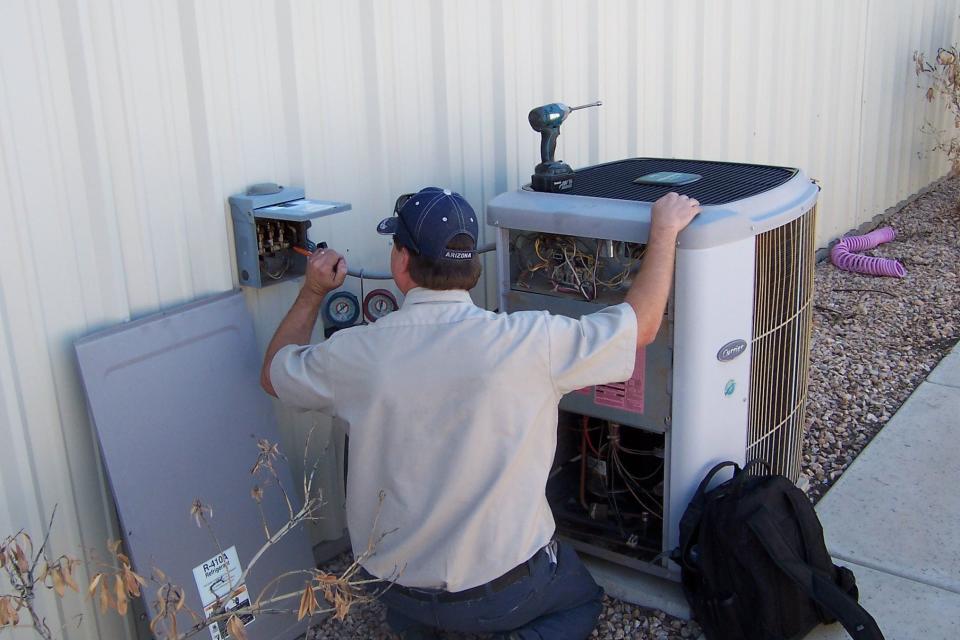Supply, labor shortages could delay Arizonans' air conditioning repairs this summer

As summer approaches, Arizonans may prepare for scorching temperatures by wearing oven mitts while driving to protect from hot steering wheels, or mimic viral trends to see if they can cook food on asphalt.
But one important seasonal check that people might forget is to make sure air conditioning units are working in their homes.
Supply shortages lingering from the earlier days of the COVID-19 pandemic continue to affect the availability of some parts, and it may take longer to make all the necessary repairs.
As in other industries, HVAC companies have faced rising demand and decreasing supply.
Shortages at the supplier level have consequences that trickle down to servicing businesses. When the people who do repairs cannot get the parts they need, jobs that would be simple become impossible.
“(I’m still) behind from two years ago when manufacturing shut down, and demand has gone through the roof,” said Mike Donley, president of Donley AC and Plumbing. “They never caught up.”
Citing one example, Donley said most thermostats, motors and air conditioners require chips to make them work, but since production of these chips has slowed, current repairs on a variety of units are affected.
Audrey Monell, president of Forrest Anderson Plumbing & Air Conditioning, said supply and labor shortages have built up over the past two years.
"The supply shortage is really starting to hit us hard right now, because everybody's backlogs run out. And even equipment is about three months out on some of our jobs," Monell said. "Now, everybody's warehouses are depleted, and they're trying to manufacture the products basically as we order them."
Ferguson is a major supplier of maintenance parts, including for HVAC units. The company attributes the current state of the industry to “astronomical” shipping delays, a labor shortage crisis, demand being high while supply is low, and to inflation causing additional price hikes on almost all items.
“We are all under pressure from the unpredictable challenges inflicted by COVID-19. When the pandemic first hit, suppliers, distributors, factories and carriers tightened their belts and braced for the worst, never envisioning that demand would skyrocket causing unprecedented material shortages, product price increases and ongoing supply chain disruptions impacting every product category, supplier and consumer,” a spokesperson for Ferguson said in a statement.
Donley predicts this summer will be difficult, with continuing inconsistencies in supplies affecting a range of repairs. He said he meets with his suppliers regularly to see where they are in production so that they can make predictions of what parts will be available each week in an effort to minimize shortages.
“The customer doesn't have as many choices as they used to, very similar to a car lot if you go shopping for a car right now,” Donley said. “You don't have a lot of choices. You just get what's there right now.”
In addition to the universal supply shortages heightened by the pandemic, Donley said the HVAC supplier industry might be working slower than usual in the coming months as a result of the Environmental Protection Agency changing its efficiency standards for central air conditioning and heating pumps.
HVAC companies must prepare to create new parts that match higher Seasonal Energy Efficiency Ratio standards. In general, the higher the SEER rating, the less electricity the air conditioning system needs to do its job.
“They're having to retrofit their factories and their manufacturing lines to manufacture the new equipment,” Donley said. “That is also putting a crimp on supply because they're having to shut down to retool factories or having to redesign things. And so they're not producing as many air conditioners.”
Donley suggests that homeowners consider replacing parts on their air conditioning units over 12 years old now rather than later, so that they do not have to wait weeks to months for parts to come in should their unit break.
“It's really going to be dictated by heat and demand,” Donley said. “We have a hot summer and a lot of the units break, or they have to be replaced. ... I'm sure shortages will be felt more.”
In case one does find themselves stuck waiting for parts on a broken air conditioning unit, Donley suggests having a backup plan in place to stay safe when the Arizona temperatures reach 100-plus degrees. Some homes have two cooling units, so families can just stay in the part of the house where the air conditioning still works. In other cases, though, he advises going to stay with a friend or family member if possible.
Monell said Forrest Anderson tries to accommodate customers who must wait for air conditioning repairs by providing them with portable evaporative coolers, especially during the hot summer months.
Labor shortages have hit air conditioning repair businesses hard, but Monell said she has hope that the problem will be resolved in the next few years.
"More and more people, it seems, just recently are getting into the trades—learning that a four-year degree isn't for everybody, and you can make a very good living in skilled trades," Monell said. "So more people are going to vocational school, and that'll really help with the labor shortage, I think."
Reach the reporter at endia.fontanez@gannett.com. Follow her on Twitter at @EndiaRain.
Support local journalism. Subscribe to azcentral.com today.
This article originally appeared on Arizona Republic: COVID-19 related supply, labor shortages could delay AC repairs in AZ
